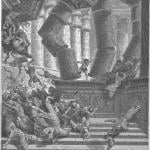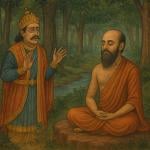
Another passage from one of my books in progress:
The new gospel preached by Jesus and Paul and the other apostles was, in a certain sense, the universal reformed Judaism of which Hellenistic reformers—at least those of the better sort—had long dreamed. The blessings of Abraham were now available to all, provided only that they accepted Jesus and his teachings. “There is,” wrote Paul, “neither Jew nor Greek . . . for ye are all one in Christ Jesus. And if ye be Christ’s, then are ye Abraham’s seed, and heirs according to the promise.”[1] But we should not mistake the situation and begin to think of the early Hellenizers as forerunners of the religion of Jesus. Christianity is a voluntary, almost democratic, form of religion, quite unlike the aristocratic religion that the Hellenizers had tried to force upon their people by means of power and wealth and through the use of military force and the extortions of tax-collectors.
Paul’s audience was immense. There were millions of people throughout the Mediterranean who were ready for the message of Christianity. First of all, there were the Jews of the diaspora, of whom he himself was one. There were a million of them in Egypt alone, and they outnumbered Gentiles in two of the five “quarters” of Alexandria, which was the second city, after Rome itself, in the ancient Mediterranean world. There was a substantial colony of them in Rome, as well as in major cities such as Damascus and Antioch and Ephesus. They were in Gaul (today’s France) and in Spain and northwest Africa. Many of them, however, found that it was very difficult to live according to the rules of Judaism in these far-off areas. They did not want to abandon their religion, but they felt themselves hemmed in by the details and minutiae of the Mosaic law and by the practice of circumcision. For many of them, Christianity seemed to be precisely what it was—a heaven-sent deliverance. The same was true for the large number of pious Gentiles throughout the Mediterranean basin who sympathized with Judaism, who accepted its basic teachings on the nature of God and the ethical demands he makes of his followers, but who were reluctant to undergo circumcision and to bind themselves to the hundreds of rules that accompanied the religion. The Christians now offered what could be considered a form of Judaism, but one stripped of unpalatable aspects—including its sometimes obnoxious ethnocentrism and intolerance and its insistence that Gentiles were ritually unclean and should be avoided—that had made Judaism unacceptable to otherwise sympathetic outsiders. (Under Jewish purity requirements, it would have been difficult for Gentile converts to continue interaction with their own “unclean” families, to say nothing of employers, military commanders, and customers.)
Thus, a form of what can be considered Judaism not only survived, but as every reader of this book well knows, spread throughout the entire world. On the other hand, Judaism itself survived, too. Originally, most Christians had been Jews. After a point early in Christian history, however, it had become clear that the vast majority of members of the Church were not Jews and had, in fact, had no prior contact with Judaism at all. The huge success of Christian missionary efforts among the Gentiles, accompanied by the destruction of the Jewish homeland in Palestine, left Jewish Christians in the minority and guaranteed that there would be little confusion between Judaism and Christianity in the future. Furthermore, the triumph of Hellenistic Christianity, and the demise of Jewish Christians, made it even easier for Jews to denounce and castigate Christianity. Wasn’t it just another form of the old enemy, Hellenism? In a sense, that is precisely what Christianity was becoming, since, with the rise to dominance within the Church of converted Hellenistic pagans, numerous pagan ideas began to enter the Christian church. Christianity was losing touch with its Jewish roots. By the end of the first century or the beginning of the second, formal prayers against heretics, including Christians, had become a part of the Jewish daily service. By the time of the second Jewish revolt against Rome, in 132 A.D., the Christians were seen as open enemies, and early Christian writers report that Simon bar Kokhba massacred Christian communities as well as pagan Greek ones. As Paul Johnson writes,
The Jews could not concede the divinity of Jesus as God-made-man without repudiating the central tenet of their belief. The Christians could not concede that Jesus was anything less than God without repudiating the essence and purpose of their movement. If Christ was not God, Christianity was nothing. If Christ was God, then Judaism was false. There could be absolutely no compromise on this point. Each faith was thus a threat to the other.[2]
Meanwhile, Judaism itself was undergoing major changes. The cataclysmic end of the Bar Kokhba rebellion guaranteed that Judaism would no longer be a national religion, since no Jewish nation was left. The rituals of the temple had already vanished, along with the temple itself, in the first revolt against Rome. Thus, Judaism became a religion focused almost entirely on the study and observance of the Torah. There had long been a tendency in this direction. The reforms of King Josiah, the career of Ezra the scribe, the advent of the synagogue as another place of meeting beside the temple, the rise of the Pharisees, the revolt of the Maccabees, all of these developments had emphasized the importance of the Torah. But now there was nothing else. The temple was gone, and the state was no more. The Jews were scattered, and they had only one thing that they could carry with them—the Law.
[1] Galatians 3.28-29.
[2] P. Johnson, History of the Jews, 144-45.
Posted from St. George, Utah











